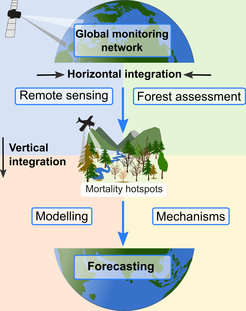
Global trends in tree mortality
In 2009, Craig Allen published a world map with dots indicating instances of elevated tree mortality and forest decline from heat and drought. Ever since, researchers from all across the globe are concerned about climate change risks for forests. The number of dots on this map has constantly increased over the years (Hartmann et al. 2018, New Phytol, Hammond et al. 2022, Nat Comm) and this sends an alarming message. Yet, we still don’t know whether these dots represent a systematic trend in global tree mortality in response to climate change.

During the last decade, I have pursued several initiatives to address trends in global tree mortality. Already in our 2015 Science paper (Trumbore, Brando & Hartmann 2015, Science), we highlighted the need for long-term monitoring of forest condition, and we further developed this concept into two international scientific initiatives, the IUFRO task force on Monitoring global tree mortality patterns and trends and the International Tree Mortality Network. Both initiatives pursue the goal to facilitate sharing, harmonization, and open-access provision of data on tree mortality (Hartmann et al. 2018, New Phytol).

In May 2022, we published the first open-access database of climate change-induced tree mortality. This database has already allowed highlighting the difficulties in scaling from ground to satellite and forecasting of tree mortality, even for very severe die-off events (Hartmann et al. 2022, Ann Rev Plant Biol). Furthermore, the database has allowed identifying a globally-robust climatic fingerprint that triggers tree mortality basically in all forested biomes (Hammond et al. 2022, Nat Comm). Such a fingerprint can serve as a empirically-derived mechanism in vegetation models to forecast tree mortality into regions reaching the climatic threshold with ongoing global warming.
Please stay tuned for further developments!

